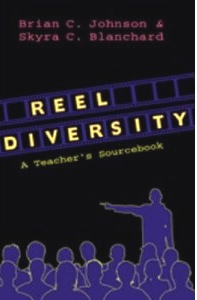December 2010 – Volume 14, Number 3
Reel Diversity, A Teacher’s Sourcebook
|
|||
| Author: | Brian C. Johnson and Skyra C. Blanchard (2008) |  |
|
| Publisher: | Peter Lang Publishing, New York | ||
| Pages | ISBN | Price | |
|---|---|---|---|
| 283 | 978-1433104039 | $34.95 | |
Prefacing Reel Diversity, A Teacher’s Sourcebook, Brian C. Johnson and Skyra C. Blanchard, both with extensive experience in education, film studies, language and literacy education, present the volume with the hope that it might “serve as a resource manual for teachers who want to introduce and infuse the concepts of diversity and social justice into their courses” (ix) through the analysis of films and movies. The sourcebook is motivated by the argument that K-12 classroom based critical examinations of Hollywood productions can help bring to light the part the industry plays in individual’s informal cultural education and the many racialized and gendered stereotypes internalized by the U.S. public. Through structured critical examination, films can be used as a means discussion of social issues and/or injustices.
The book does live up to its claim to act as a manual. One of its beginning chapters contains guidelines for teaching diversity and the articulation of a common lexicon, and the presentation of a course on US diversity with an emphasis on film. Synopses of films are given, the underlying diversity “theme” (i.e., gender, sexuality, race, etc.) identified as are suggested topics or questions for group discussions and other activities.
The authors argue against a narrow understanding of diversity uniquely surrounding questions of race. Instead, race is a “cultural iceberg” (6) with observable attributes of various culture above the surface and emotional and cognitive features below the surface. Put another way, one can know what Native Americans look like, but not how they think or feel. They believe that Hollywood has done a disservice by reinforcing the limits of that view through the characters offered. It is only through recognizing and highlighting this shortcoming that a true study of the proliferation of stereotyping can occur.
In the offered guidelines for developing a course on American Diversity, the authors recommend specific films be used and guide instructors to learning outcomes. They “analyze contemporary American films with particular attention to story lines and plot, genre conventions, thematic meaning and interpretation, and characterization” (19) with pre-film viewing units dealing with the deconstruction and understanding of the concept of “culture.” They suggest using 10 – 12 minute clips of films that contain underlying issues followed by group discussion. They offer suggested questions to spark those discussions. The rating of each film is included.
The greater portion of this manual identifies over 100 suggested films for classroom use. While some may be obvious such as Brokeback Mountain, I personally was surprised by others. However, the dissection of those films by the authors makes it clear that many seemingly innocent films do indeed contain underlying themes. For example, the Oompa Loompas of “Charlie and the Chocolate Factory” are all played by the same man. The authors suggest that teachers discuss whether or not this may “reflect how agent groups may view the perspective of target groups” (122) and whether or not Charlie’s takeover of Loompa Land reflects how the U.S. has infiltrated other countries. The themes of exploitation and marginalization are suggested as concepts for discussion.
In short, this book is an excellent resource for educators, including EFL/ESL professionals, who are aware of and sensitive to diversity issues or want to become so. It not only illuminates the more subliminal messages projected through popular films, it also offers concrete strategies for challenging those messages in a classroom setting.
Reviewed by
Rosemary Chipley
Independent Educator, Charlotte North Carolina, USA
<rchipley![]() uncc.edu>
uncc.edu>
|
© Copyright rests with authors. Please cite TESL-EJ appropriately.
Editor’s Note: The HTML version contains no page numbers. Please use the PDF version of this article for citations. |

